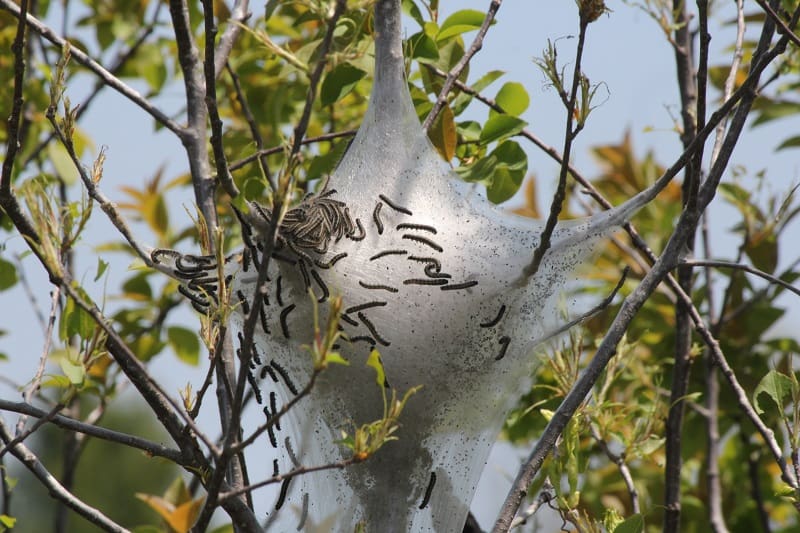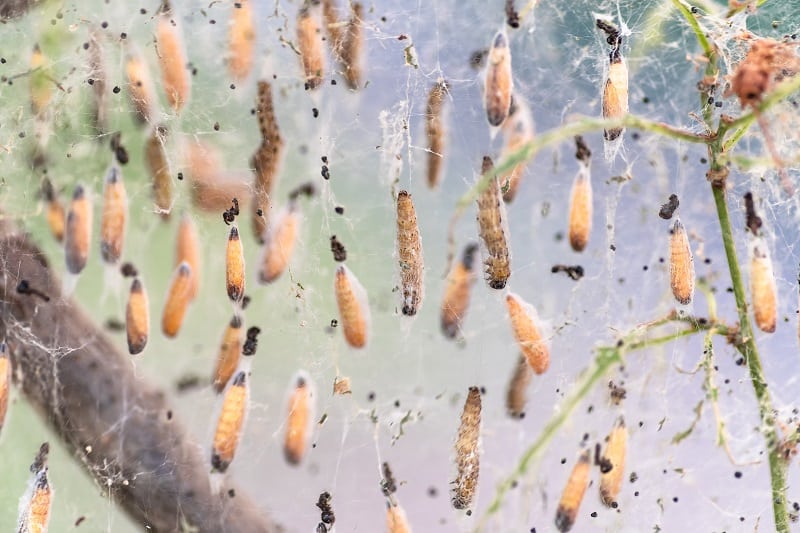The world of moths is a diversely fascinating and extensive realm of knowledge. This is why researchers and bug enthusiasts alike have been enamored with many aspects of a moth; from its colorful scales to its interactions with light. But where exactly do these bugs live? How do they find shelter from the cruel parts of nature?
Moths do not build typical nests. Adult moths fly around in search of food and mate. The caterpillars crawl about looking for food. In both stages, they take temporary shelter wherever it is convenient. The closest they come to nesting is when they lay eggs or accumulate as pupae in cocoons.
Despite not being as colonial as bees or wasps, many species of moths do gather in large numbers, particularly when they are in their larval stage. And some species can become a serious pest problem.
So, it is important to identify where and how these moth species gather and grow.
Do Moths Build Nests?
When you think about a nest for insects, your mind probably conjures up the image of a beehive. Or you might picture a subterranean structure where ants and termites typically live.
These places serve several functions. They provide shelter from harsh weather and predators as well as a safe place for breeding and raising offspring.
But moths do not build any such establishment.
This does not mean that moths live completely separate lives from one another. At different stages of their lives, depending on their needs, moths will come together and form a colony that will resemble something like a traditional nest.
Moths have four distinct phases in their entire life cycle. The most recognizable of these stages is the ADULT MOTH.
These are the flight-capable, colorfully scaled, creatures, you see hovering around street lamps or in the attic.
Adult moths do not live for a long time. And in that short time, their main objective is to find a suitable partner for mating, while finding food is a secondary objective for most species.
So, they do not require a nesting ground to store and share food.
You can spot multiple adult moths in the same place taking shelter or hovering around a light source. But that is mostly a temporary situation and they will happily go to a new place if it is more convenient.
After mating, the female adult moths will lay their eggs in any area that can provide shelter, usually many at a time.
The eggs will remain in a cluster, which may give the illusion that this is a moth’s nest.
But it is more an accumulation of hundreds of eggs rather than a compound structure.
From the eggs, CATERPILLARS will hatch and immediately search for food. They move slowly, do share the same birthplace, and look out for the same food. That’s why these caterpillars can be found in a group before they separate over time.
Now, some moths will build mobile cocoons during their larval stage. Examples of such moths include clothes moths, bagworms, brown tail moths. These moths will build a cocoon with an opening on top. This way the caterpillars can easily come out when they find food. The browntail moths also use this cocoon to shelter them from the winter.
When the caterpillars reach the PUPA STAGE, which is the stage prior to becoming an adult, they will attach these cocoons to a solid structure.
Inside the cocoon, the moths start their metamorphosis process as the entire structure remains stationary.
And it is during this stage that you can associate moths with a nest-like structure.
After all, a nest is any stationary establishment that provides its occupant with the necessary shelter.
So, if you ever see a moth’s nest anywhere, it is most likely the collective cocoons of numerous moth pupa transitioning to become adults.
Where Do Moths Nest?
Now you know that the only time moths will stay inside a nest-like structure is when they are caterpillars that are either looking for food or a safe place to complete metamorphosis. And caterpillars have one specific duty; eat as much as they can to have enough energy for their metamorphosis.
As such, you will commonly find their cocoons near places where food is readily available. Many moth caterpillars carry their cocoons with them. So, they can set up their base where they can get easy access to their food source.
Since different moths have different dietary needs, they also nest in accordingly.
House
Moths that can be found inside a human house are the pantry moth, carpet moth, etc. The pantry moth will infest food grains in the kitchen. Carpet and clothes moths will nest in the closet, where they can feed on clothing materials, furniture, etc.
They usually don’t enter the house from nature but from infested food and clothes. These moths spread fast under friendly conditions and can reach numerous populations.
You will recognize an infestation normally by detecting adult moths flying around.
One of our related topics: Where Do Moths Go During the Day? (And Why)
Attic
The moths living indoors feeding on our food or clothes are also happy finding shelter and nutrition in the attic. While meal moths are rarely seen there, it can be a paradise for the clothes moths when the stored clothes aren’t sealed.
The moths aren’t disturbed and can develop for a long time before being discovered. You should package your clothes safely and check the attic regularly for any pests.
Chimneys
Natural moths can use any entrance to your home to enter it and look for shelter and food. (How Long Can a Moth Survive in a House?)
But these species do have a very short lifespan and normally can’t reproduce in human houses. Moths in your chimney can occur now and then but don’t pose any threat to your environment.
Nevertheless, you should check if these moths are domestic species. Having clothes or meal moths in any part of your home can become a serious problem and should be treated immediately.
Outside
Outside of human homes, wild moths will build their cocoons in trees or bushes. This way the caterpillars can come out very easily to feed on their preferred plant.
When the caterpillars get ready to enter their pupa stage, they will fix their cocoons to the underside of a leaf or twig. Occasionally, such cocoons can be found on the ground though it is rare.

Tent caterpillars deserve a particular mention in this regard. The caterpillars of these moths are extremely social, meaning they are almost always found in large colonies. They set up large silk tents on the branches of the trees they reside in. Hence, they are called tent caterpillars.
How Do Moth Nests Look Like?
The majority of moth caterpillars create their cocoon by spinning silk around themselves.
This shell of silk can take on various forms but they are almost invariably white.
The caterpillars can be seen crawling inside or outside of the cocoon. They roam outside when they are about to feed. Once they reach their pupa stage, they will remain dormant. They will shut off any opening on the cocoon and will stay this way until they reach full maturity.

The tent caterpillar is a good example of this nesting process. They have acquired their names from the tent-like nest they build on host trees. The size of the tents varies according to the size of the colony. You will see these nests hanging from the twigs or branches of the trees. Sometimes the nest may be attached to the trunk of the tree.
Occasionally, you may find a large collection of moth eggs and mistake it for a colony. In reality, this is no permanent nest. Moths will lay their eggs wherever they find ample shelter and easy access to food. Because the first thing the caterpillars will search for after hatching is food to sustain their rapid growth.
Typically, these eggs look like tiny pears or white orbs. The eggs are usually in a cluster.
But the size of an individual egg is rather small. It is only when a moth lays hundreds of eggs together do they become easily noticeable to the naked eye.
How to Eliminate Moth Nests?
While most moth species prefer the wilderness and avoid human interaction, some species do live among us. Species such as the clothes moth, the carpet moth, and the pantry moth can pose a serious threat of infestation, ruining fabrics and food products.
So, it is important to properly identify their infestation and take steps to eradicate them.
1. Clean the Infested Area
Household moths have a few common places for setting up base. The corner of the closet or the attic or the pantry are ideal places for them. So, if you suspect you have a moth infestation in your home, you need to clean the infected area thoroughly.
Vacuum the rugs and carpet to remove the larvae and pupa hiding there. Also, clean your closet and the pantry to destroy their eggs.
Remove everything that appears to be a nest or an element of the moth life cycle.
2. Remove the Food Source
Pantry moths gain entry into your home through infected food grains. Once populated, it is very difficult to separate the food from the moths. So, it is best to just remove the food source entirely from your house.
You can do the same for any furniture or rug that has been damaged by moths. These fabrics are the prime food source for carpet moths. So, by removing any such furniture, you immediately take out a lot of their population.
3. Apply Essential Oils
These ancient oils are used for many years and claim to have various effects. Some are also popular for repelling flying insects like moths.
The most popular ones are lavender, cedar oil, peppermint, and eucalyptus. Most of them don’t have real proof of effectiveness, but it is worth a try.
4. Use Green Pesticides
Before applying chemicals in your house you should always consider using non-toxic methods. After you identified your moth species you should seek some natural remedies and give them a chance to prove their effectiveness.
5. Spray Classical Insecticides (not recommended)
When all methods didn’t work out (and that is very very rare), you probably want to apply a classical insecticide. Those products are widely available but should always be applied as instructed.
You should also try to avoid any place where humans stay for quite a while (like your bedroom).
If you are still unsure how to get rid of moths it is best to call in a professional.
How to Prevent Moths from Nesting
First, you need to know how moths infiltrate homes. Carpet moths come through old furniture and rags. Pantry moths enter through infected food grains. So, removing these sources of entry is the best way to prevent a moth’s nest from growing in your home.
Avoid domestic moths:
- recheck endangered areas regularly
- avoid open food sources
- stored clothes should be sealed
- wash new clothes as hot as allowed
If you are concerned about natural moths you might remember that those insects usually don’t reproduce or nest inside your home. But you can avoid their appearance easily with some simple measures.
Avoid natural moths:
- use mosquito nets
- avoid open windows / doors (esp. in the night)
- avoid light sources
- remove food sources
Conclusion
Some moth species are more social than others but they all require some form of shelter. As such, they will build cocoons to provide a safe place for searching for food and to go through their transformation into colorful, adult moths.
These structures can accumulate and give the impression of a moth nest, but it doesn’t have the same purpose and character as a beehive.

